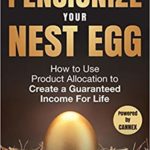 By Dale Roberts, CuttheCrapInvesting
By Dale Roberts, CuttheCrapInvesting
Special to the Financial Independence Hub
Most Canadians do not have a defined pension with guaranteed income. Speaking of birds and nest eggs, those guaranteed pensions are going the way of the dodo bird. Just 33% of Canadians have a defined benefit workplace pension where the income is guaranteed and usually indexed to inflation.
That’s according to Pensionize Your Nest Egg: How to Use Product Allocation to Create a Guaranteed Income For Life.
There’s only one way for me and you to create a generous and guaranteed income stream and that’s by way of the annuity. It’s a topic and product category that gets little attention. And when it gets attention it’s often negative. Annuities are offered by insurance companies. Strike One. Annuities come with ‘high fees.’ Strike Two. Let’s not go to Strike Three; we want to keep this blog post alive. In the process we might keep your retirement in good shape as well.
Hear me out. I’ll admit that I have not been a fan of the annuity in the past. I’ll also admit that I knew very little about annuities. That’s always a good way to form an opinion, right? Give that thumbs down based on the headlines and 5 minutes of research. So please join me in a more than surprising and interesting discovery of just what the heck an annuity is.
With an annuity you simply purchase your own pension
Yup, it’s that simple. As an example, you hand over $100,000 and the insurance company will pay you monthly income, guaranteed for life. Of course that’s a Life Annuity. There are a few types of annuities, but for now we’ll stick to the most common and most popular annuity.
And of course the rates available will fluctuate based on a few factors. Here’s a site that will give you an idea of the rates available in today’s market.
In March of 2019 here are the rates for a Canadian single male. The payment is in the range of 6% annually for a male at age 65.
 You can purchase an income stream for life. And of course, the longer you wait to purchase that annuity the greater your payments. You might stagger your annuity purchase(s) over many years and periods of your retirement. That’s typically the advice found in Pensionize Your Nest Egg and offered from advisors who Pensionize a portion of their clients’ nest eggs.
You can purchase an income stream for life. And of course, the longer you wait to purchase that annuity the greater your payments. You might stagger your annuity purchase(s) over many years and periods of your retirement. That’s typically the advice found in Pensionize Your Nest Egg and offered from advisors who Pensionize a portion of their clients’ nest eggs.
When you hand over your money, it’s a done deal
These are irreversible contracts. When you purchase an annuity you usually exchange control of those funds for guaranteed income for life. When you die, your money goes to the insurance company. To be exact, a portion of your monies goes to the survivors: to those who purchased annuities and who might live to 85, 90, 95 or 100. That’s how insurance companies can afford to pay you rates that are well beyond the bond and GIC rates of the day. With an annuity the unlucky (the dead) pay for the lucky (the living).
In the above quote table there is a 10-year guarantee, meaning that the payment would continue for 10 years from time of purchase even in the event of an early death.
Many Canadians are living well into their 90s
And from the many tools available at pensionizeyournestegg.com here’s a shocking survivability table for a 65-year-old male.
 For a 65-year-old Canadian male there’s a 25% chance that they’ll live to age 94. Yikes. What side of the annuity grass will you be on? This table demonstrates why a certain level of guaranteed income might be a good idea. You might at least cover your basic living needs for life and projected oldage home payments with guaranteed income.
For a 65-year-old Canadian male there’s a 25% chance that they’ll live to age 94. Yikes. What side of the annuity grass will you be on? This table demonstrates why a certain level of guaranteed income might be a good idea. You might at least cover your basic living needs for life and projected oldage home payments with guaranteed income.
The 3 product allocation buckets
The main theme of Pensionize Your Nest Egg is to think product buckets, not traditional asset allocation that would normally include your mix of cash, GICs, stocks and bonds. Instead the theme and 3 buckets is …
- Guaranteed Income For Life.
- Guaranteed Income Plus Growth Potential.
- Asset Growth Potential (your personal portfolio)
Of course Bucket 1 will include government monies, private pensions with an asterisk*, and your personal pension (annuities). Bucket 2 is annuities with some ownership of stock and bond mutual funds that might deliver added growth if the markets and funds cooperate. Bucket 3 is your personal investable dollars – your portfolio.
*your private pension holder could go belly up. See General Motors.
The book then goes on to demonstrate that if you arrange your assets in the right buckets at the right time you can increase the odds of creating more generous income for life. The book and tools also help create a plan that will allow you to leave a financial legacy if desired. And that is the big question that needs to be answered. Do you want your monies to protect your longevity risk and contribute to your quality of life in retirement, or do your kids and other heirs take precedent?
Personally, I would strike Bucket 2 off of the list, entirely. Bucket 2 includes mutual funds that usually come attached to very high fees. Those high fees are likely to eat up most of the stock and bond market gains. I’ll do more research on the topic, but I’m quite confident that I know how this movie ends. I’ve done my research on market-linked guaranteed income products and they are usually quite terrible and confusing. I think you can do better with Bucket 1 working with Bucket 3. If we want to benefit from the growth of the stock markets we need to participate in that growth in the most cost-effective manner possible.
Have a read of Beat the Bank from Larry Bates. High fees can eat up half of your investment gains over longer periods.
Your investments might then take the form of an ETF Portfolio, Canadian Robo Advisor, or One-Ticket Solution.
Treat annuities like super bonds
I am with notable retirement scholar Wade Pfau, who often calls annuities Super Bonds.
Consider an income annuity as part of your overall fixed-income allocation, says Wade Pfau, a professor of retirement income at the American College. “Income annuities are superior to bonds, but not necessarily superior to stocks,” he says.
Mathematically speaking, investors would come out ahead if they replaced their entire fixed-income investment portfolio with income annuities, Pfau says. But this is unrealistic: “It doesn’t account for needing funds for unexpected spending,” he adds.
Here’s the full article, yes, with a US perspective.
It’s not all or nothing with annuities
Here’s one of the main themes of the book. Moving on from egg shells here it is in a nut shell. When you pensionize a portion of your nest egg you can then move on to create greater income from your retirement portfolio. It might be a win, win. Greater income security + greater overall retirement income.
From page 84, this is ‘the money’ quote for me.
In fact, we would go so far as to say that once you wrap true longevity insurance around a diversified portfolio (by “pensionizing” a portfolio of your nest egg) you can actually tolerate and afford more risk.
And you might ask about the risks. There is issuer risk. On that you might spread the risk among providers and do your homework.
Co-author Alexandra Macqueen advised that …
Annuities are insured via Assuris, which covers 85% of the annuity payment up to $2k per month.
If a lifeco company fails the assets are transferred to a solvent company.
From table to nest egg?
The goal of the book is to make retirees and financial planners aware of the benefits of annuities and guaranteed income. While not for everyone many retirees would benefit from guaranteed income that currently pays twice or more the going rates for bonds and GICs.
The book does not intend to offer a financial plan. But now that annuities are on the table they might end up in your nest.
Thanks for reading. Of course this blog post is not advice and not a recommendation of annuities. The retirement stage can be more than complicated. Many retirees and near retirees will benefit by obtaining advice. You might contact a qualified fee-for-service advisor.
Kindly hit those share buttons for Twitter, Facebook and LinkedIn at the bottom on this article. You can Follow Cut The Crap Investing at the very bottom of this page.
Send a note to Dale, I’m at cutthecrapinvesting@gmail.com or better yet leave a comment on this post.


